The Passion of Joan of Arc, 1928, directed by Carl Theodor Dryer, written by Joseph Delteil and Carl Theodor Dryer.
I've watched this movie five or six times in the last few weeks, and I haven't come close to plumbing its depths. It's searing, harrowing, pick your adjective. I've been trying to describe the effect it had on me, the experience of watching it, and I don't think I'm a good enough writer by half. So let's stick to the facts.
First we can rule out what it's not. The Passion of Joan of Arc is not The Messenger or anything like more recent treatments of Joan's life. Dryer doesn't give a damn about Joan's military exploits. No one plays the Bastard of Orléans or Charles VII. The Hundred Years' War could be the Twenty Minutes' Disagreement for all the difference it makes to this film. Of course, you wouldn't have needed much context, in France, in 1928. Joan's ecclesiastical rehabilitation was finally complete; excommunicated in her lifetime, she had been canonized in 1920. Joan's status as military hero had been used as a call to arms throughout France during World War I, particularly after the Germans bombed Reims cathedral. Here, she's triumphing over a silent-movie-villain looking Kaiser Wilhelm:

Joan was also used to drum up support for the war in the United States and even (demonstrating somewhat selective memory of her achievements), Great Britain:

And I would only be a little surprised to find her on a German recruiting poster ("Joan of Arc Slaughtered the British. Women of Germany..."). So you wouldn't have needed much context. But Dreyer didn't make a film about Joan as national hero, savior of France; his film could really have been set anywhere. And he didn't make a biopic. Instead, The Passion of Joan of Arc ignores the more obviously cinematic parts of her life and deals exclusively with Joan's trial for heresy in the late winter and early spring of 1431. The movie does have a reverent attitude toward Joan, but it's a different kind than France had at the time. Compare Joan's depiction in the recruiting posters with Dreyer's first shot of Maria Falconetti playing her:

Both the camera and the monk to her right look slightly down on her, she takes up less than a quarter of the image, and she's framed by her captor's weapons. Throughout the film, we will see Joan behaving intelligently and honorably, but not heroically. The Passion of Joan of Arc is not a French version of Henry V.
The Passion of Joan of Arc is also not The Passion of the Christ or anything you might find in the Lives of the Saints. This was something of a relief for me; narratives of martyrdom have always struck me as a little vulgar, satisfying our base instincts while claiming to appeal to our higher ones (for a quick example of what I mean, check out Henryk Siemiradzki's A Christian Dirce; the nicest thing you can say is that the painter's attitude is conflicted). I haven't seen The Passion of the Christ, so I'll stay out of the debate about the explicit torture scenes, but here's Gibson describing why the movie is so violent:
So that they see the enormity—the enormity of that sacrifice; to see that someone could endure that and still come back with love and forgiveness, even through extreme pain and suffering and ridicule.There's an assumption here that by witnessing suffering we come to a better understanding of it. Martyr, after all, comes from the Greek for "witness." Gibson further seems to be asking the audience to consider what it would be like to undergo the same sacrifice (someone could endure that"). The Passion of Joan of Arc doesn't work that way. We are continually denied the ability to identify with Joan; and whenever we reach the comfortable assumption that we know more about her than her judges and tormentors, Dreyer yanks the rug out from under us. One of the ways he does this is (again) through the complete lack of context; but this time it's lack of visual context, not historical. Consider a single line, about halfway through the movie:
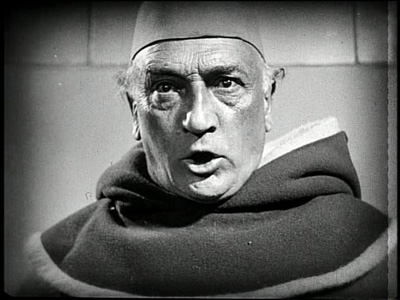
This is roughly a point of view shot, from Joan's perspective. On close examination, there aren't that many; usually the camera is closer than she is. The judge says (in the intertitle), "Don't you see that it's the Devil who has turned your head..." and we cut to Joan:
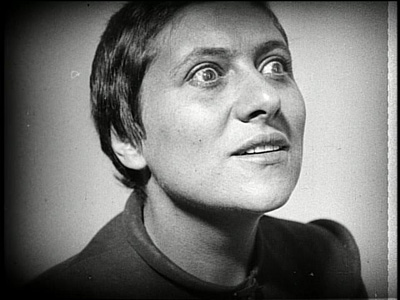
So far, so good. The shot is noticeably off from the judge's perspective (the camera is a little lower and to his left, if we assume that the preceding shot was Joan's POV). This would be a typical way of shooting a scene, if the director wanted us to identify with Joan: modify the standard shot-reverse shot so that one shot is from Joan's POV and the next is third-person. But then we cut back to this:
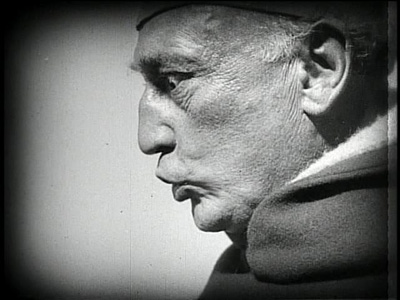
...right before the judge finishes his sentence with "...who has tricked you?" Now we're not looking at the scene from any perspective at all. Assumptions we were making about knowing how sitting there felt to Joan aren't valid. "Who has turned your head, who has tricked you," indeed. Dreyer cuts back to the earlier shot of Joan, before revisiting the "point of view" of the first shot, with a difference:

But now we're uncomfortably close, and again, clearly not seeing things from Joan's perspective. And then the last shot of her:
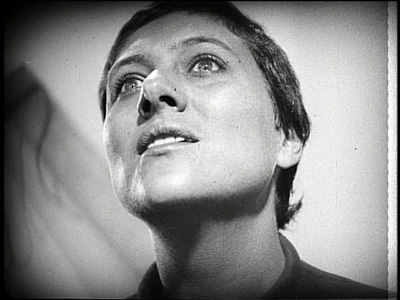
As Mark Twain might say, the 180° rule is not just broken, but flung down and danced upon. The result is disorienting and a little exhausting. Notice also, that nothing carries from one shot to the next. That's Dreyer's strategy throughout; as David Bordwell pointed out (via Roger Ebert): "Of the film's over 1,500 cuts, fewer than 30 carry a figure or object over from one shot to another; and fewer than 15 constitute genuine matches on action."
Let me be clear; although we are denied the ability to truly identify with Joan, I don't think we're implicated with her judges. To me the film seemed to have more to say about the impossibility of identifying with anyone at all, especially at the last extremities of faith and suffering. Here's a telling exchange during Joan's first interrogation. The judges, trying to trick Joan into blaspheming, ask the following:
"You have said that Saint Michael appeared to you. In what form? Did he have wings? Did he wear a crown? How was he dressed? How did you know if it was a man or a woman? Was he naked?"
Joan replies only to the last question, "Do you think God was unable to clothe him?" When asked if he had long hair, she answers, "Why would he have cut it?" This is treacherous: Joan is dodging her interrogators, but also making the point that her experiences are incommunicable. Language is inadequate to describe her visions. You will not find many narrative films with as little faith in storytelling as this one. To the extent we try to judge or understand her, we're in the position of their interrogators, who are uniformly as old and unattractive as the one pictured above. You'll notice that I don't refer to any of them by name: although they have names in the screenplay, they're never referred to by name on screen and frankly I'm not sure who's who. But that's sort of the point; they're barely distinguishable. They don't always look angry, though; from time to time, they smile at Joan with infinite condescension:
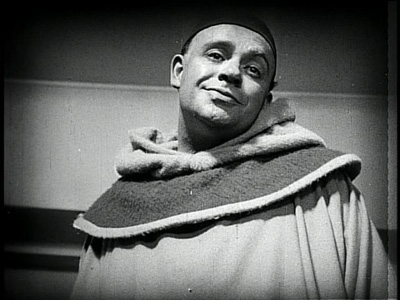
That's the face of a man who knows he's right. But as I've already noted, we don't really get to identify with Joan, either. So where does that leave us? One way of reading the movie would be to see it as Nabokov saw Cervantes:
The author seems to plan it thus: Come with me, ungentle reader, who enjoys seeing a live dog inflated and kicked around like a soccer football; reader, who likes, of a Sunday morning, on his way to or from church, to poke his stick or direct his spittle at a poor rogue in the stocks; come... I hope you will be amused at what I have to offer.
That would put us back in Passion of the Christ territory, though, and that's not what Dryer is up to either. Although the film does invite us to watch Joan's tormentors slowly and methodically destroy her, and although the experience is extremely unpleasant, we are explicitly asked not to consider her judges as garden-variety sadists. One way Dreyer does this is by putting a few garden-variety sadists in the film: Joan is tormented between interrogation sessions by her jailers, including this upstanding fellow:
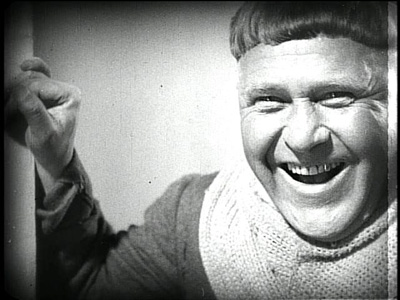
I suppose it's the difference between Pilate and the Roman soldiers, an analogy Dreyer makes explicit when Joan's jailers force her to wear a straw crown:
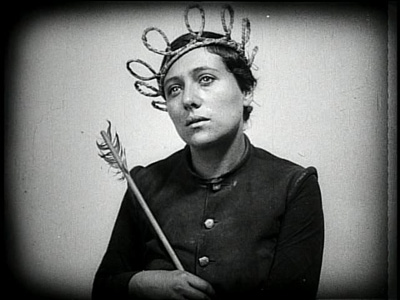
The church officials don't take pleasure in destroying Joan the way her jailers do. But Dreyer suggests that the compassion of the church is worse. One of the monks rescues Joan from the jailers, sends them angrily away, and wipes her tears. Then he takes her to the torture chamber.
So: we're not being asked to watch Joan's destruction for our own pleasure. We can't understand what she's going through, but we're not really implicated or invited to judge her. What's left? I would suggest that one thing the film teaches is compassion, in the older sense of the word (suffering along with). Here's Joan at her lowest point, after she has signed an abjuration she does not understand, denied that her visions were divinely inspired, and been sentenced to life in prison. One would think that her torments were over, but Dreyer cuts from her sentencing directly to this:
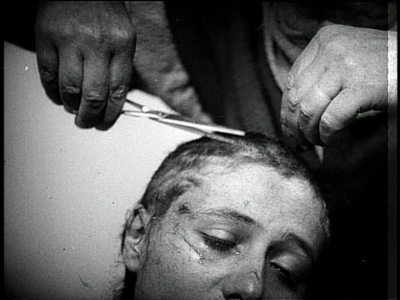
It's impossible to watch this penultimate humiliation without wanting to do something, anything to stop it. This is the polar opposite of Cervantes trying to amuse us with cruelty. The Passion of Joan of Arc cuts to the quick of what it is to be human; what, exactly, we have in common with Joan, despite the fact that her experiences are incommunicable. It's worth noting that the judges feel this, too. When Joan recants her abjuration and condemns herself to death, her murderers weep. But they kill her anyway, because they believe they serve something more important than humanity. Joan signs her abjuration when she is most reminded of her own mortality, facing execution and confronted with a maggot-filled memento mori.
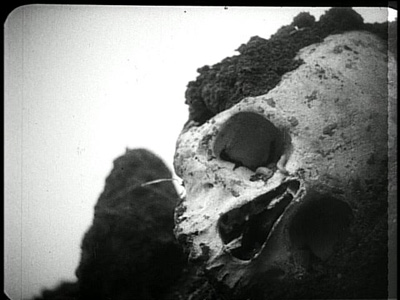
Mortals have one thing in common that transcends all ideology; we're headed to the same place. You're thinking, reading this, that the historical Joan would have disagreed with it. The point of the "vast, moth-eaten musical brocade" that she and her captors agree on is that it promises something beyond becoming worm food. And Joan was no anti-ideologue; she killed for her beliefs, and in the end she dies for them. After she burns, the closing intertitles tell us
The flames sheltered Joan's soul as it rose to heaven—Joan whose heart has become the heart of France... Joan, whose memory will always be cherished by the French people.
That suggests, in a few seconds of screentime, that her martyrdom, and the French identity it engendered, somehow made the agony we've been watching for the last ninety minutes "worthwhile." Although she suffered, her country benefited. But this is undercut by the chaos surrounding her death. Those French people who cherish her, who share her heart, are driven into an ecstasy of rage at her death and rebel against their British captors. The British cheerfully slaughter the lot of them.
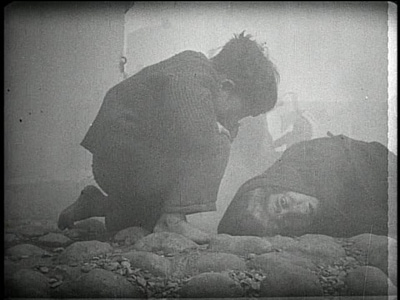
As far as we see on screen, Joan's death only brings more death, her suffering more suffering. And although we may wish to stop it, we can't even understand it. The Passion of Joan of Arc is the rarest of films, the kind whose violence does not desensitize, but instead raises sensitivity to an unbearable pitch. While Joan burns, Dreyer abandons the closeups and sharp focus he's treated her with in earlier reels. She is obscured by smoke, then by flames. In the end, this is all the mercy the film can offer. The camera's ability to record suffering does not exceed our ability to withstand it.
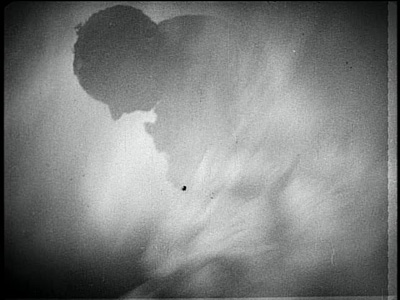
Randoms:
- Maria Falconetti's performance is the best I've ever seen. And it's her only major film role; if you're going to be on film just once, you could do worse than this. Dreyer wrote about her, "In Falconetti, who plays Joan, I found what I might, with very bold expression, allow myself to call 'the martyr’s reincarnation.'" His phrase seems fair. Her eyes are impossible to meet.
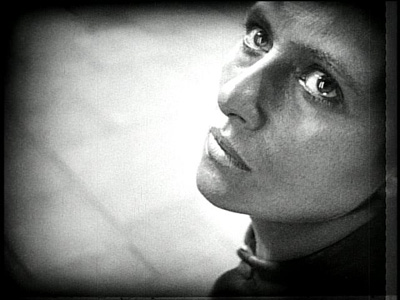
- One bit of trivia about Falconetti; the film was shot in sequence, and she had hoped to convince Dreyer not to cut her hair by the time they got to that scene. So she's genuinely miserable there.
- Rudolf Maté's cinematography is, as you've already noticed from the stills, stunning. He used new-at-the-time panchromatic black and white film, which allowed him to shoot without using makeup. In fact, Dreyer forbid his actors from using it throughout the shoot. One thing you don't get from stills is the remarkably fluid camera movement. Watch for a beautiful tracking shot that follows the judges as they whisper a question to try to trick Joan with:
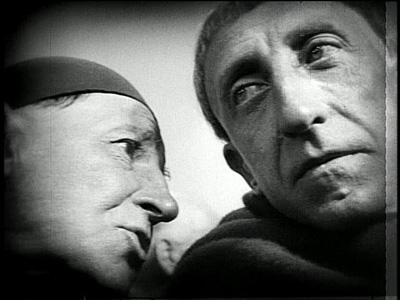
- The camera pans right as each whispers to the next, much more smoothly than in other films I've seen from this time.
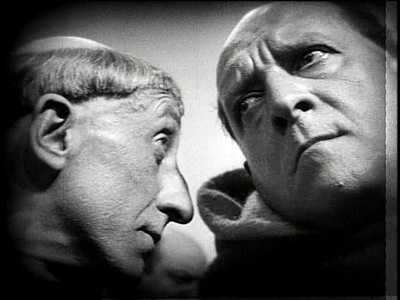
- The composition of this shot (and the flat, oddly proportion backgrounds throughout) reminded me of Giotto:

- And the lighting, while anachronistic for Joan's trial, often recalls Caravaggio.
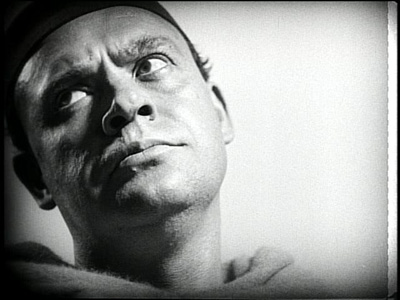
- Even the insert shots are beautiful:
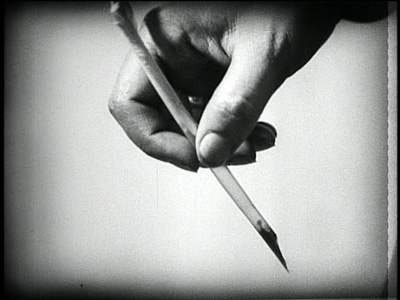
- I think that the beautiful photography (and the rhythmic, methodical editing) has a great deal to do with the film's effect; together, they give it the feeling of a dance. And the more Joan's suffering seems planned, methodical, and inexorable, the more you consider why she is suffering.
- One of the United States' new favorite alternative interrogation methods makes a cameo:
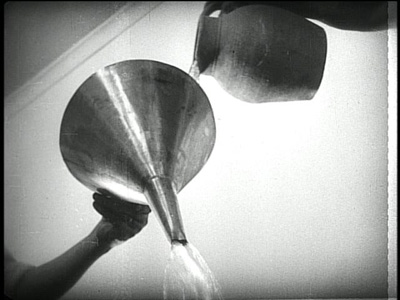
- Since this one's a "no-brainer" when lives are at stake, imagine how easy it was to do when souls hung in the balance!
- The film's provenance is as muddied as Joan's history. The original negatives and all extant prints were lost to fire; Dreyer recut the film using alternate takes, and then that version was burned, too. All people had seen were bastardized, recut versions; one was dubbed, one had the intertitles superimposed on still shots of churches and stained glass, &c., &c.. Then, in 1984, a print of the original, long lost cut, turned up in a closet in a Danish mental institution. I'm not making that up. The Criterion version is from that print. I'm curious about the discoloration you see in the right side of each frame. The print would have been separate reels, but it seems to have affected all of them.
- Exteriors on The Passion of Joan of Arc was filmed on one of the most expensive (if not the most expensive) exterior sets of the time (at least in Europe). And it's almost completely invisible, given Dreyer's penchant for close-ups. Here's a model of its layout, the only way to see the whole thing.

- Note to aspiring filmmakers: spending millions on a set that you don't shoot is the kind of thing producers love.
- It's a commonplace complaint that film productions run on the blood of underpaid and underappreciated production assistants, but no one took this quite as literally as Dreyer.
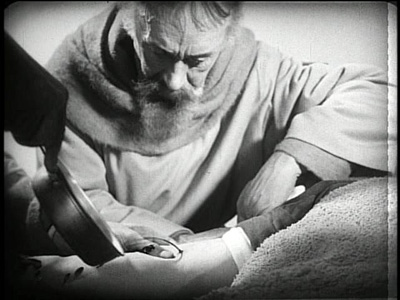
- Someone donated their vein for the bleeding scene. That's not an effect, that's an actual arm shedding actual blood. In fact, disgustingly enough, one of the ways to identify the second cut of the film, the one from alternate takes, is that the blood doesn't spurt as much:
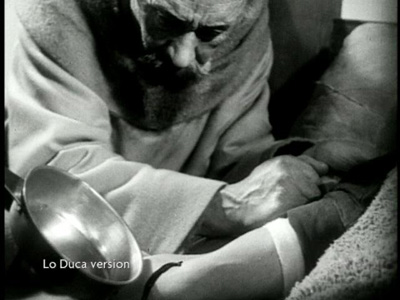
- Because of course by the time they got to that take, the PA's blood pressure had dropped. From all the bleeding. I thought the worst story along those lines I'd heard was that a PA was tased on the set of Hannibal when no actor or stuntman was dropping as fast as Ridley Scott would have liked (the way I heard it, the PA got hazard pay and a chance to hang out and talk about movies with Ridley Scott; not a very good deal). But The Passion of Joan of Arc takes the cake.
- This is a strange question, but it's been bothering me since I saw the film. Can anyone identify the graffito on the wall in this still?
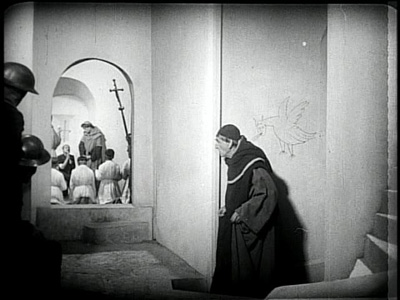
- Here it is blown up:
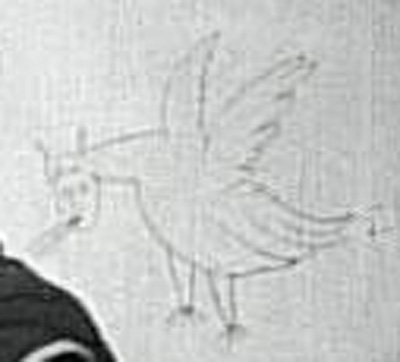
- I know I've seen this creature, drawn in this style, somewhere before, but I can't remember where.
- Dreyer hated having his movies shown with musical accompaniment (and the DVD actually has an audio track that has nothing but silence on it; you would think viewers could just hit MUTE). I am going to go ahead and advise you to ignore his wishes in this matter, though, because the second audio track sets the film to Richard Einhorn's "Voices of Light," an "Opera/Oratorio," as the DVD has it, inspired by The Passion of Joan of Arc. The music is beautiful, haunting, wonderful; it suits the film perfectly. The pace of the editing is perfectly matched by the methodical counterpoint in Einhorn's score (particularly during her early interrogations and the scene in the torture chamber). Even if it wasn't written to be a score to the film, precisely, it goes down as one of the best silent film scores ever.
- If I haven't made it clear enough by now: WATCH THIS MOVIE, PLEASE. You'll wonder how you lived so long without knowing it backwards and forwards.


55 comments:
wow, you have a fantastic site, and all the time in the world, it seems, to analyze films frame by frame. i envy you. :) am also a criterion collection diehard, and dreyer's 'passion' was one of my very first purchases. i hope to read more of your posts. mind a link-up? i've added you to my blogroll. :)
Jack, thanks. No, I saw your comment, I just haven't had time to answer--there's no protocol here. Usually the day after I finish a review, I search my gmail for comments and answer them, but work's been nuts today. Re: Gus Van Sant, I'm afraid I don't have too much of an opinion one way or the other. The only films of his I've seen, embarrassingly enough, are To Die For and Good Will Hunting, and I saw those both years ago. I liked To Die For and I thought Good Will Hunting was a brilliant script, in terms of it being a very smart career move for Affleck and Damon (carefully writing a script that Miramax would let them star in), but didn't love it as a movie. I'm looking forward to seeing My Own Private Idaho when I get to it; even if I hate the movie (unlikely), I give Van Sant a lot of credit for rediscovering Udo Kier. What's Gerry like?
Matt
Gibbs Cadiz, thanks for the kind words; glad you're enjoying the site. I don't have all that much time, or I'd go through these much faster. If I'd known The Passion of Joan of Arc existed, it would have been one of my first purchases, too. Re: blogrolling, thanks for the link, and I'll be glad to add a link the next time I post.
Thanks for your great blog and an excellent review of Passion of Joan of Arc. Like you this is probably one of my favourite versions of the story just edging out Robert Bresson's The Trial Of Joan Of Arc, though I haven't had the chance to see Jaques Rivette's two part (part one is 'the battles' and part two is 'the prisons') epic from 1994 Jeanne de Purcelle yet. Rivette's film stars Sandrine Bonnaire who turns up in the Criterion Collection in A Nos Amours (No. 331), but you will come across her sooner than this when you reach one of her defining roles in Agnes Varda's Vagabond (No. 74). It would be interesting to watch Vagabond with some of your comments on Passion of Joan of Arc in mind, since that tale is similarly about making the audience feel compassionate about the drifter's tragic relationships with others and final fate, and making us wonder whether we would have felt or done the same as those people she meets on her journey to her final resting place.
I like the way you say: "Exteriors on The Passion of Joan of Arc was filmed on one of the most expensive (if not the most expensive) exterior sets of the time (at least in Europe)." Are you already aware of the other film in the collection that had an enormous set built that was barely seen in the final film? Kurosawa's Red Beard (No. 159)! I thought that might be why you qualified your statement with (at least in Europe)!
I was wondering - when you watch each Criterion do you also try to watch all the extras on a disc? That is something I like doing - sometimes I find the extras make me think better of a film I didn't particularly like (like the wonderful documentary on Jubilee (No. 191)) and give me another perspective.
Re: My Own Private Idaho - you are going to love Udo Kier's self-penned song while he dances with a hotel lamp! Or his nipple clamps being used on Keanu Reeves!
Sorry A Nos Amours is number 33[b]7[/b] in the Collection!
Matthew,
Absolutely wonderful analysis of the film, it's clear how much it grabbed you.
I watched it about a 18 months ago and wasn't as enamoured, but I might give it another spin; it was the first Dreyer that I had seen.
I know it may be forever before you get to it, but I'm looking forward to seeing your analysis of the films in the Dreyer box set; of the 3, only Ordet really grabbed me. I found Gertrud to be extremely tedious and, dare I say, boring. Day of Wrath was better, but Ordet really grabbed me on a lot of levels.
Keep up the good work.
Yet another wonderful review, Matthew.
Continued luck on your trek through the great, endless hall of Criterion.
I caught Joan of Arc when it came on the Turner Classic Movie channel. Unfortunately, it was 1 or 2 in the morning, so I could only stand 30-40 minutes of it.
But, my god, the images struck me like thunder bolts. I honestly have no idea how Dreyer or his cinematographer did it, but each actor's face look it was a sculpture cut from stone - rigid and terse and commanding each inch of the frame.
I have never seen anything like it before or since.
By the way, I read somewhere, I believe it was in Roger Ebert's Great Movie Guide (you can find it for free on his website), that Dreyer actually used a method of breaking Falconetti down to get a better performance from her. He made her sit on her knees on the stone and remain in position for long periods of time and other such tasks of this nature. And it was all for the sake of the film.
One last thing: what do you think of Criterion's new design? Specifically, I mean how the logo has changed from an underlined "Criterion Collection" at the top of the DVD case to that vertical block on the left side accompanied by the big "C" a few inches above it.
There could possibly be, or probably is, more changes made inside the case as well as in the DVD menus, but, anyways, from what you have seen, what is your opinion?
Your shot by shot breakdown of the critical "it's the devil" scene is really wonderful.
It's true that Dreyer won't let us fully identify or take sides with either party, and I was really impressed by how hard he makes it to sympathize with Joan, since we naturally _want_ to do so. At the same time, I had the impression that Dreyer did want us to sympathize to some degree with the reasonability of the interrogators--to share their belwilderment at Joan's madness.
I think there's an attempt to insist upon religious faith as so beyond understanding that it appears as madness--this theme is particularly evident in Ordet, where a young man studies too much Kierkegaard and decides he's Jesus Christ--there's no way you can see his character as anything but batshit crazy, even if, as the film sometimes suggests, he's not.
That weird graffiti chicken looks familiar to me, too. Could it be from a Hieronymous Bosch painting? Or maybe one of the Breughels?
I mentioned this in the comments of an earlier review, but did you happen to notice the "first person shooter" style camera work in the final scenes? I don't recall exactly, but I think they were actually firing some sort of cannon--and the camera shot down the barrel.
Also, you didn't mention this, but for whoever might be interested, the actor playing the priest in the first still is the marvellous, mad, and fascinating poet and theatre theorist, Antonin Artaud.
Great site and project idea, and a particularly good analysis with screen captures. What software do you use to grab the images from the DVD?
Hey, remember back in the day, when you used to review movies. That was awesome!
Canadian Bull-frog, those days are coming back soon. Everyone else, more when I'm done traveling--headed home tomorrow. Apologies for my absence.
Colinr0380,
This is actually the only Joan of Arc film I've seen; it would take a lot to better it. I often am way out of my league on this site because the reason I'm watching these movies is because of how little I know about film. I haven't seen Red Beard, but I'm looking forward to it. The reason I qualified my statement about the set is because it was similarly qualified on the commentary track. I believe the set for Intolerance was larger, but I am judging that pretty much entirely on the basis of the scale of Hollywood and Highland, which may not be the most reliable source. I am, in fact, watching all the extras on each disc, except where there is a dubbed English audio track for a foreign film; I don't think there's really that much to learn from that.
And yes, I'm looking forward to My Own Private Idaho.
Jim,
Give it another spin—you might find, as I did, that Einhorn's score adds a lot, if you weren't watching it with that. I am looking forward to seeing more Dreyer; probably around 2025 unless I really pick up the pace! Thanks for the kind words re: the site.
Anonymous,
Yes, I hear that Dreyer was pretty miserable to work with. Falconetti had the worst of it but I think the actors who had to wear a tonsure for months for a few days of shooting (with a hat!) probably win the absurd-demands-of-actors award. I like the new Criterion logo. It's actually their third logo design for DVDs, and there's an earlier logo on their laserdiscs. The new one is by far the most easily identifiable they've created. And I guess as long as you're not creating something outright barbarous (to steal a phrase from Orwell), the whole point of a logo is that it be immediately recognized.
ckdexter,
Thanks for the kind words. Yes, I did notice, but didn't write about, the first-person shooter camera work—but I didn't make the connection to Branded to Kill until you refreshed my memory. Actually, looking back at my entry on that film, I see that Yan gave me a heads up about that shot ahead of time. I think the commentary identifies that shot in The Passion of Joan of Arc as both (1) Lifted from Battleship Potemkin, and (2) anachronistic, because it shows a cannon pivoting to aim.
I'm looking forward to Ordet. I still haven't identified the drawing, but I'm pretty sure it's not Bosch or Breugels. Still looking, though. I don't know Aurtad at all—is there something of his you'd recommend reading?
Phyrephox, thanks for the kind words. I use InterVideo WinDVD 6 to take the film stills, and crop them in Adobe Photoshop.
Yan, c'est moi--ckdexter's just my blogger name.
Artaud's most famous work is probably his theatre theory in Theatre of Cruelty (I believe he also wrote a bit on cinema--he wrote the screenplay to an early classic surrealist film, the Seashell and the Clergyman), but I'm partial to his fascinating literary output--a strange amalgum of poetry and prose, autobiography, psycholoanalysis, fantasy and carefully transcribed delerium. The closest comparison I can think of is Lautreamont's Chants de Maldoror, but he's really an utterly unique and eccentric figure.
His books are short, so they're published in various collections. The Artaud Anthology published by City Lights is short, but an excellent selection of writings, as is the much more exhaustive Selected Writings from University of California Press. Representative individual works include Nerve Meter, Umbilicus of Limbo, and To Have Done With the Judgement of God (a radio performance). Both the text and original audio of the last one are available online, the audio at http://www.ubu.com/sound/artaud.html
Yan/CK Dexter—sorry I didn't put it together sooner. I'll check out the Artaud Anthology; he sounds very interesting. Thanks for the info!
The drawing (graffiti on the wall) is of a Harpy. I will leave it to you to look up and determine the symbolic significance of the Greek mythological creature, known for its cruelty and ravenous appetite, represented by the drawing on the wall in the Christian torture chamber.
In the Middle Ages, the harpy, often called the "virgin eagle", became a popular charge in heraldry, particularly in East Frisia, seen on, among others, the coats-of-arms of Reitburg, Liechtenstein, and the Cirksenas.
Anonymous,
Thanks--that's very helpful!
Great review of The Passion of Joan of Arc. Tell people that can watch it for free at MaidofHeaven.com
http://www.maidofheaven.com/
I'm impressed with the photos that accompany this review. I'm in the process of publishing a PhD dissertation on Joan in film and am gathering photos.
My great concern is obtaining permission.
Whom did you address to obtain copyright permission for the use of these photos?
Thanks.
MJMaddox,
The short answer is, nobody. They're screen captures from the DVD, which you can make a case for under fair use in a critical context. In any event, Criterion knows I use them (they link to my site from theirs), and haven't said boo, so I think it's okay. Your mileage may vary with more recent films—although most studios have legal departments that handle this sort of thing, assisting academics is pretty low on their priority list. On the other hand, prosecuting academics is also pretty low on their list, so you've got that going for you.
I was so happy to run across your blog - what a great idea. Thought you might appreciate hearing about "The Passion Project," and finding yourself on my To Do list:
http://blogs.wnyc.org/culturist/2008/07/11/what-you-are-doing-this-weekend/
Cheers,
claudia
Matthew,
Thanks for responding to my question about copyright.
Since asking it I've come across various essays on the question of fair use of video frames. Your brief comment sums up the consensus. I've found a program called VLC which I'll be using to grab the frames I want to use.
I made the mistake of writing to one studio regarding the Preminger Saint Joan. I asked about permission to use the poster and a production photo I'd come across on the web. They responded with a form letter saying that they were "not licensing stills from Saint Joan at this time." I've since been advised that it is NOT a good idea to write for permission.
Is there any way to grab frames from a VHS tape? The Saint Joan does not exist on DVD.
By the way. I write movie reviews for Bella Online and have a section devoted to Joan of Arc films:
http://www.bellaonline.com/subjects/3414.asp
Matt, the drawing on the wall is a Basilisk, a poison-spitting demonic chicken from Medieval mythology (J.K. Rowlings is wrong when she has a Basilisk as a serpent in Chamber of Secrets). If you tried to stab the evil fowl, its poisonous blood would run up the weapon and eat into your flesh. So it must have been an Alien chicken.
Anyway, I think Dreyer intended this to reflect the Church or the English or the Judges as being poisonous chickens.
Matthew--
I found your blog three or four months ago and have by now read almost every review, so I thought it was probably time I showed some appreciation. Almost every movie in my queue is there on a recommendation from you: your reviews are entertaining, informative, intellectually honest, forgiving, and they don't sound at all as if they're intended to be a last word.
Your writing has encouraged me to think more rigorously about film, given new perspective on movies I've seen a hundred times, and led me to other film resources I'd not have found otherwise. So thanks.
I really loved The Passion of Joan of Arc--I saw it a year or so ago and every few months since then.
But recently I saw another Dryer picture, Ordet, and though I loved much of the movie the ending really left a foul taste in my mouth, and I find it a tough case for the number one spiritually significant film of all time (http://artsandfaith.com/t100/). Though I don't expect any kind of in depth response to this, I await your evaluation of Ordet and hope you can shed some light on it.
Jacob Clary
Claudia/Culturist,
Well, it's been a year--was finally looking at this post again and reailzed I never replied. Hope your weekend in July of 2008 was everything you'd wished for...
MJMadox,
You posted this a long time ago, but my response is that the easiest and cheapest way I know to get stills from a VHS tape is to buy one of those VHS-to-DVD recorders and then get a DVD still. That link doesn't seem to go to Joan of Arc movies anymore--have they been relocated?
Sean,
I'm a big fan of poisonous chicken wings. Thanks for IDing that.
Jacob,
As the flurry of other posts shows, I haven't exactly been diligent about replying to commenters, but I wanted to respond to your comment--thank you very much for the kind words. I can't wait to see Ordet—The Passion of Joan of Arc is the only Dreyer I've seen. My film illiteracy appalls even me. But when I get to it, I'd love to hear what you thought of it...
Matthew,
first of all: Thank you so much for your wonderful blog. I love your reviews.
Recenty, I watched Joan of Arc with a friend of mine who is a professional art historian. He told me the architecture wasn't accurate. I did some research and found two pictures that might be interesting for you:
http://1503mk.vafk-karlsruhe.de/pics/joan1.jpg
and
http://1503mk.vafk-karlsruhe.de/pics/joan2.jpg
(From: Pierre-Gilles Gerault, Joan of Arc, English Edition, Editions Jean-Paul Gisserot 2004)
Obviously, Dreyer wasnt't wrong. He just had a very special perspective in his mind.
Do you have any idea why he used modern eyeglasses and scissors in his movie?
Mike
Since first commenting here I have published my Joan of Arc dissertation and migrated my movie reviews to my own site www.MjMaddoxonline.com
If anyone is interested, an overview of my Joan of Arc book can be seen here.
The starting place for my reviews on six Joan films, including the Dreyer, can be found here.
- Show quoted text -
Thanks for this thoughtful review, Matthew. I must say that I found your reference to faith in Christ as a "vast, moth-eaten musical brocade" a bit jarring. The line of the poem that you quote goes on to say "...Created to pretend we never die." As someone who went from being an atheist to a believer at the age of 30, I can say that finding a way to live forever has almost nothing to do with it. It is a matter of entering into a relationship with a Person. To me that was one of the most striking thing about this movie--the presence of an unseen Person as registered on Joan's face. Her last word was his name.
GTT,
That's a very thoughtful comment—I'll grant that Larkin (and my) view of religion from the outside is limited in some important ways. Are you saying that you got the sense of "an unseen Person as registered on Joan's face" in the final scene, or throughout the movie? To me, at least, it seemed that the absense of just about any grace at all was the film's defining characteristic.
Hi Matthew,
I read this post -- and a few others I've gotten to so far -- with great interest. I recently saw The Passion of Joan of Arc and found it very striking, amazing and intense. Actually words fail me, too.
I think your comments on it are very insightful. For me, as a Christian, I find that I can identify with Joan only to the extent that I, like her, identify with Christ in his suffering.
A verse from the Bible says, "that I may know Christ and the power of his resurrection, and may share his sufferings, becoming like him in his death, that by any means possible I may attain the resurrection from the dead." Most of us -- Christian or otherwise -- would be happy to know Christ and his life-from-the-dead power . . . but who wants to share in his sufferings? It is optional -- i.e. not required for salvation -- yet it is the path of greatest intimacy with Jesus.
So for me, Joan is difficult to identify with partly because she has chosen a path of following Jesus that is largely untrodden by the rest of us . . . me, at least. I find the film reassuring because it reminds me that a faithful life is often hard -- but God promises an eternal life whose glory will make the sufferings of this life pale in comparison.
To me, that is the grace in this film -- visible only with eyes of faith, probably.
Thank you so much for this blog! It's a great accompaniment to my own new interest in the Criterion films. (By the way, I was a Duke nerd camper, too . . . I love Spinal Tap.) I'm now slowly watching Children of Paradise and resisting seeing what you have to say about it (if you've seen it yet) until I'm finished with it.
Kristi,
Thanks for the thoughtful comment; I'm glad to hear you're enjoying the blog. I haven't written about "Children of Paradise," so no worries there.
Re: Joan, I find your perspective on this interesting, because it seemed to me that the closing intertitle puts the emphasis on Joan's value to France, not her personal salvation (her soul may rise to heaven, but she lives on in the hearts of the French people). Do you see a difference between Joan's story and other stories of martyrdom?
Hi Matthew,
I'm not sure what you mean by other stories of martyrdom -- could you clarify?
I agree with your comment on the closing intertitle. What made the film personally very meaningful (in addition to its spectacular-ness as a film) may have been intentional -- but may not -- I don't know. (I've seen it only once.)
Some movies have a depth of spiritual meaning that as far as I can tell is unintentional (such as some salvation-metaphoric stuff at the end of Fight Club). And that makes them more interesting -- that there is room for one to interact with the movie -- and I would say that Joan of Arc is one of those movies.
I hope you see Children of Paradise soon -- it is fascinating.
Kristi (not really GTT -- computer is on my husband's id now)
Kristi,
I mistakenly selected your last comment when clearing out some comment spam and deleted it, so I'll quote it (since it was e-mailed to me):
on 2nd thought, Matthew, I get your question. Of course Joan's story isn't like other martyr stories -- that just makes it more interesting and also makes the church's position easier to understand and identify with.
Kristi
What I was saying re: Joan is that 1. She was a military and political figure as much as a religious one, and 2. her story has been adapted by a wide variety of political interests for a wide variety of purposes, in ways other saints and martyrs have not been, at least to my knowledge. But you got that.
For me, the film is not so much communicating a message about Joan's salvation as it is pointing out how impossible it is to communicate these things at all--but perhaps we are both reading things in unintentionally from our own spiritual perspectives.
Your blog was fantastic. I was looking up more info on this movie after having watched it in Film Arts class. Many of the students thought Dreyer's vision of Joan as weak, considering she had led an army, etc.. I thought that it was a shame that their impressions had been tainted by whatever knowledge they had or thought they had on Joan of Arc and were unable to sit objectively and take in the view of Joan that Dreyer gave us. I absolutely loved your writings on this film, it was incredibly helpful, and incredibly well written. Thank you.
jubileetwist,
Thank you! Glad you enjoyed it.
It may be silly to answer a four year old question but I think Sean is mistaken in his chicken explanation of a basilisk. Checking Wikipedia, it is clear that a basilisk is a serpent (and JK Rowling is right) and not a chicken. He may be thinking of a cockatrice which has wings, while a basilisk does not. I had always thought a basilisk was a serpent/reptile sort of thing.
Since the thing on the wall has wings, it is likely a cockatrice which isn't a very pleasant character either. This what Wikipedia says: "Its reputed magical abilities include turning people to stone or killing them by either looking at them — "the death-darting eye of Cockatrice"[6] — touching them, or sometimes breathing on them."
Side point to an awesome review:
I don't think Cervantes really wanted to entertain his readers by showing them cruelty. He treats Quixote and Sancho with real compassion, at least in Book Two. The episode of the blown-up dog comes from a joke insulting the madman who does the blowing. The humor there doesn't come from the dog's suffering.
Thanks for this - my husband and I just watched the film last night, and I really appreciate your analysis and particularly the photo of the set model. - Mac
I was quite taken by surprise when I noticed that one of the religious who bring Joan her Viaticum is wearing glasses. Were glasses around way back then? It looks like an editing mistake. Great review!
Dadwithnoisykids:
Eye glasses have been around for a long time.
I don't know if a URL will work in this comment, but http://en.wikipedia.org/wiki/File:Hugh_specs.jpg
shows the detail of a 1352 portrait of Hugh de Provence which depicts a scribe wearing spectacles.
@Maeve: thanks! Now it seems less likely to be an editing mistake. God bless.
The fact that the original print was found in a mental institution is eerie, since Antonin Artaud (one of the actors, as noted above) also ended his days in a psychiatric clinic, though not the same one to be sure. The whole film has an aura of madness. Joan is in the grips of religious mania, her persecutors are demented sadists. Artaud's character may be the closest thing to a sane person in the film.
Small correction, the print was discovered in a Norwegian mental institution, not Danish. Excellent review though :)
Re. your question concerning the odd drawing on the wall, of what appears to be a winged dragon with a distorted, human face. This looks familiar to me as well; it reminds me of the seven headed dragon in the great medieval tapestry of the Apocalypse in the castle of Angers.
This site is to much immpressiv and atracted also good job an keepit up.
logo company in Pakistan
Logo design online in Pakistan
Speaking of Artaud, I'd suggest reading a little about his vision of the "Theatre of Cruelty", Matthew - it's a sibling of Dreyer's approach here.
Great Review!! I just want to hear about 'Au Hazard Balthazar' from you.
I identified completely with Joan in this film, and thus I don't identify with your claim that we aren't allowed to identify with her. Camera angles can play a role in identification with character but it is far from the only thing. Falconetti's performance and the story of what is happening to Joan, the contrast between what she set out to do with how she has ended up, the threats of torture, the contrast of her grandiose visions with her bleak surroundings, all lead me to immensely identify with the character. In no way did I feel like the film was encouraging us to withhold identification.
Was just at a viewing of this film accompanied by The Orlando Consort. All of the music they performed was contemporary to Joan's lifetime, so think a capella, polyphonic, and mostly religious. The music was amazing and blended perfectly with the film down to a singing of the Lord's prayer in Latin when Joan was reciting it in the film. They also added some effects such as whisperings during the tracking shot of the judges. For more info and especially a scene breakdown with the accompanying music see The Orlando Consort website: http://www.orlandoconsort.com/voicesappeared.htm
Regarding the glasses, I do think they are jarringly anachronistic, much like the modern scissors used to cut Joan's hair. However, I do not think that the glasses are a mistake by Dreyer because he seemed to be entirely intent on historical accuracy (think about the bloodletting) and glasses during Joan's lifetime would not have had arms but simply perched on nose. And the grafitto is definitely a harpy and not a basilisk or cockatrice. Think of the symbolism -- virgin eagle, Joan as the virgin warrior; harpy used as a derogatory term for women. Forgive me for pulling feminism into this, but her interrogators' real life obsession with her clothing shows one of the major problems the religious establishment had with her - her gender. Had she been a boy, she'd have been jailed temporarily and then pulled out and knighted after a time.
Post a Comment